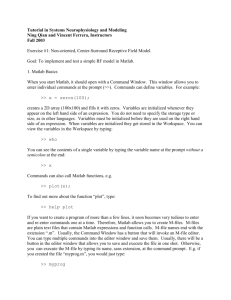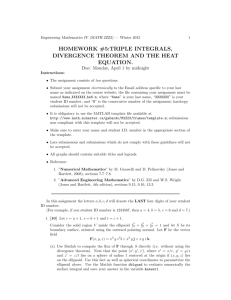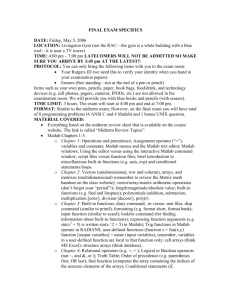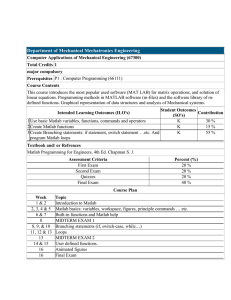M442 Fall 2013 Assignment 1, due Friday Sept. 13
advertisement
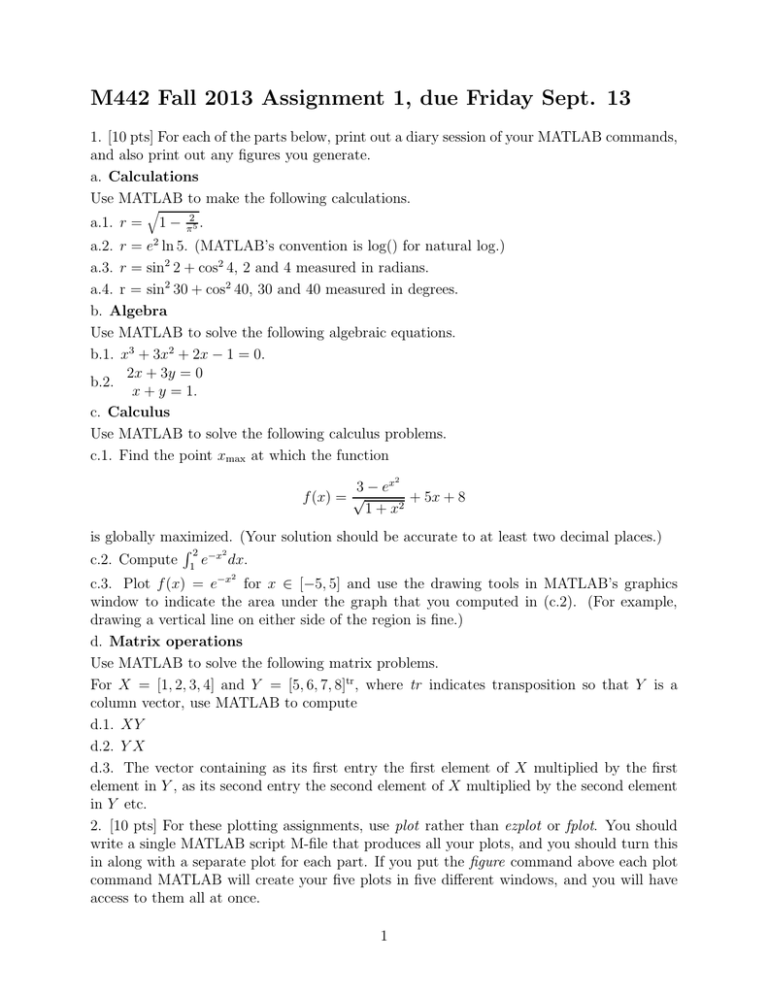
M442 Fall 2013 Assignment 1, due Friday Sept. 13 1. [10 pts] For each of the parts below, print out a diary session of your MATLAB commands, and also print out any figures you generate. a. Calculations Use MATLAB to make the following calculations. a.1. r = q 1− 2 . π5 a.2. r = e2 ln 5. (MATLAB’s convention is log() for natural log.) a.3. r = sin2 2 + cos2 4, 2 and 4 measured in radians. a.4. r = sin2 30 + cos2 40, 30 and 40 measured in degrees. b. Algebra Use MATLAB to solve the following algebraic equations. b.1. x3 + 3x2 + 2x − 1 = 0. 2x + 3y = 0 b.2. x + y = 1. c. Calculus Use MATLAB to solve the following calculus problems. c.1. Find the point xmax at which the function 2 3 − ex + 5x + 8 f (x) = √ 1 + x2 is globally maximized. (Your solution should be accurate to at least two decimal places.) ´2 2 c.2. Compute 1 e−x dx. 2 c.3. Plot f (x) = e−x for x ∈ [−5, 5] and use the drawing tools in MATLAB’s graphics window to indicate the area under the graph that you computed in (c.2). (For example, drawing a vertical line on either side of the region is fine.) d. Matrix operations Use MATLAB to solve the following matrix problems. For X = [1, 2, 3, 4] and Y = [5, 6, 7, 8]tr , where tr indicates transposition so that Y is a column vector, use MATLAB to compute d.1. XY d.2. Y X d.3. The vector containing as its first entry the first element of X multiplied by the first element in Y , as its second entry the second element of X multiplied by the second element in Y etc. 2. [10 pts] For these plotting assignments, use plot rather than ezplot or fplot. You should write a single MATLAB script M-file that produces all your plots, and you should turn this in along with a separate plot for each part. If you put the figure command above each plot command MATLAB will create your five plots in five different windows, and you will have access to them all at once. 1 a. Plot the function f (x) = x + sin x for x ∈ [0, 2π]. Label your x and y axes and add a title to your plot. b. Plot the functions x(t) = tan t and y(t) = cos t on a single figure for t ∈ (− π4 , π4 ). Label your x and y axes (i.e., your horizontal and vertical axes, since your horizontal variable will be t) and add a title to your plot. Determine (roughly) from your figure the point of intersection. c. Plot the path (x(t), y(t)) for x(t) and y(t) as defined in (b), again for t ∈ (− π4 , π4 ). Label your x and y axes and add a title to your plot. d. Use MATLAB’s built-in help to find information about the legend function, and use this function to add a legend to your plot from (b). e. MATLAB’s built-in functions text and gtext can both be used to add text to a plot at a particular location. Use the command text(0,-.2,’tan(t)’) to label the curve x(t) = tan t on your plot from (b). (This command places the text tan(t) so that its first character is at the designated position (0, −.2)). Likewise, use the command gtext(’cos(t)’) to place the text cos(t) in a reasonable location relative to the curve y(t) = cos t. (This command will open up your figure window and allow you to select the location of the text with a mouse click.) 3. [10 pts] (MATLAB M-files) In this problem, we’ll recall a few basic concepts from finance. First, if some principal investment P is invested for t years at interest rate r, then if the interest is compounded annually, the return is Rt = P (1 + r)t. If the interest is compounded twice a year (and at even intervals) the return is Rt = P (1 + 2r )2t . That is, the interest rate is cut in half over each period, but there are twice as many periods. More generally, if the interest is compounded n times a year (again, at evenly spaced intervals) the return becomes Rt = P (1 + nr )nt . Recalling that limn→∞ (1 + n1 )n = e, we see that continuously compounded n interest will yield a return governed by Rt = P ert . (limn→∞ (1+ nr )nt = lim nr →∞ ((1+ nr ) r )rt = ert .) a. Write a MATLAB script M-file that computes the return after 5 years for an investment of 100 dollars at 5% (r = .05) under three different plans: compounding annually, compounding monthly, and compounding continuously. Include both the M-file and a diary session of its implementation. b. Write a MATLAB function M-file that takes as input (in the function statement) t years, interest rate r, and principal P , and returns values through the function statement from the same three plans as described in (a). Include both the M-file and a diary session of its implementation. 4. [10 pts] An amortized loan is one in which an initial principal P0 is borrowed at some interest rate r, and payments with value v are made at equal time intervals, often monthly. (For example, car and house payments typically work this way.) Here, we are assuming r denotes interest rate for the payment period, so for example if the annual interest rate is .05 and the payments are monthly, then r = .05/12. (To be clear, it’s generally assumed in these situations that when we say annual rate rA we mean monthly rate r12A , even though monthly growth at rate r12A isn’t quite the same as annual growth at rate rA .) If we let Pt denote the remaining balance at time t, then we clearly have the difference equation Pt+1 = Pt (1 + r) − v, 2 which can be solved exactly as Pt = (1 + r)t P0 − v (1 + r)t − 1 . r a. Write a function M-file that takes as input the values r and P0 , and the duration of the loan, and returns the payment value v required to pay off the loan. b. If a car loan is P0 = 20, 000 for five years at annual rate .05, what must the monthly payment v be? 5. [10 pts] A bilinear form is a mathematical object over a vector space V that takes two vectors as input and returns a scalar as output. Also, if one of the arguments is fixed, it must be linear as a function of the other. The example we will work with for this problem is the bilinear form BA (~v , w) ~ = ~v tr Aw, ~ where A is any n × n matrix and ~v and w ~ are both n × 1 column vectors (so ~v tr is a 1 × n row vector). a. Write a MATLAB function M-file that takes as input an n×n matrix A, two n×1 vectors ~v and w, ~ and returns the value B(~v , w). ~ b. Use your result from (a) to compute BA (~v , w) ~ when A= 1 2 3 4 5 6 7 8 9 10 11 12 13 14 15 16 ; ~v = −1 −1 1 0 ; w ~ = 0 1 0 1 . c. If BA (~v , ~v ) > 0 for all ~v not identically 0 we say the matrix A is positive definite. Use your M-file to show that the matrix A from (b) is not positive definite. d. An n × n matrix A is positive definite if and only if its eigenvalues are all positive. Use MATLAB’s eigs command to verify that A has some non-positive eigenvalues. 3


